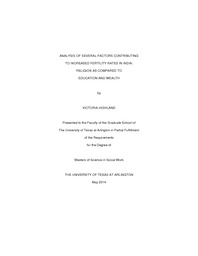
ATTENTION: The works hosted here are being migrated to a new repository that will consolidate resources, improve discoverability, and better show UTA's research impact on the global community. We will update authors as the migration progresses. Please see MavMatrix for more information.
Show simple item record
| dc.contributor.author | Highland, Victoria | en_US |
| dc.date.accessioned | 2014-07-14T20:30:20Z | |
| dc.date.available | 2014-07-14T20:30:20Z | |
| dc.date.issued | 2014-07-14 | |
| dc.date.submitted | January 2014 | en_US |
| dc.identifier.other | DISS-12611 | en_US |
| dc.identifier.uri | http://hdl.handle.net/10106/24477 | |
| dc.description.abstract | India continues to experience increased population growth, in spite of the country's nationally instituted family planning program that began in 1952. While there is research on the various factors contributing to the continued increase in fertility rates in India, previous studies have utilized older data sets (Chamie, 1981); (Yadava, 1999); (Jeffery & Jeffery, 2000); (Brookins & Brookins, 2012); (Kulkami & Algarajan, 2005). One theory about factors influencing fertility rates was explained by Chamie (1981). The theory acknowledges that fertility rates vary based on religion, but the underlying structural differences between religions has a stronger influence on fertility rates than the ideological differences. Chamie (1981) theorizes that socioeconomic factors are different between religious groups and the socioeconomic factors contribute more to differences in fertility than religious differences. The purpose of this study was to examine the differences in fertility rates between Muslim women and Hindu women in India; as well as the impact that education and wealth, regardless of religion, have on fertility rates in India. It was predicted that Muslim women would have higher fertility rates than Hindu women. It was also predicted that increased education and wealth would both decrease fertility rates and have a larger impact on fertility rates than religion. Secondary data was used from the National Family Health Survey- 3 [NFHS-3] which was a survey conducted throughout the 29 states of India between 2005 and 2006. The total number of subjects was N=124,385. Data was analyzed using an ANOVA. It was found that fertility rates of Muslim and Hindu women were significantly different (Muslim x= 0.011 and Hindu x=-0.309). It was also found that for every unit increase in education, fertility rates decreased (x=-0.777 units of children). As wealth increased, fertility rates decreased (x=-0.131 units of children). It was found that education had a significantly greater influence on fertility rates than that of religion (R² change= -0.811 > -0.304). An important implication of this study for the field of social work is the way in which education can be viewed to decrease fertility rates in India and countries facing similar population growth challenges. It is possible that programs aimed at increasing women's education level, to at least that of completing high school, would decrease lifetime fertility rates, and thus increases their self-determination and ability to gain financial resources. | en_US |
| dc.description.sponsorship | Pillai, Vijayan K. | en_US |
| dc.language.iso | en | en_US |
| dc.publisher | Social Work | en_US |
| dc.title | Analysis Of Several Factors Contributing To Increased Fertility Rates In India: Religion As Compared To Education And Wealth | en_US |
| dc.type | M.S. | en_US |
| dc.contributor.committeeChair | Pillai, Vijayan K. | en_US |
| dc.degree.department | Social Work | en_US |
| dc.degree.discipline | Social Work | en_US |
| dc.degree.grantor | University of Texas at Arlington | en_US |
| dc.degree.level | masters | en_US |
| dc.degree.name | M.S. | en_US |
Files in this item
- Name:
- Highland_uta_2502M_12611.pdf
- Size:
- 388.3Kb
- Format:
- PDF
This item appears in the following Collection(s)
Show simple item record


